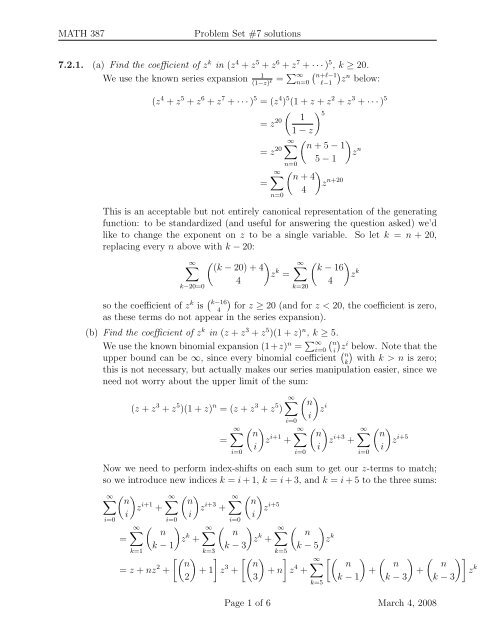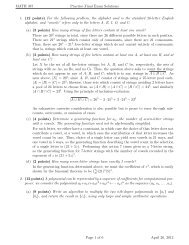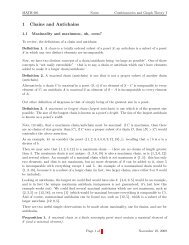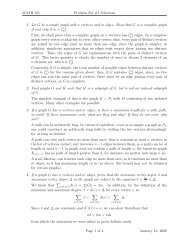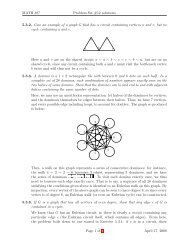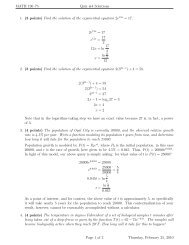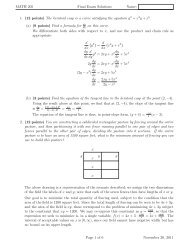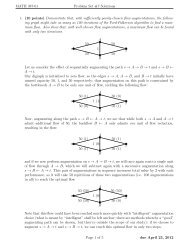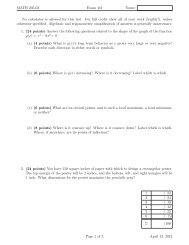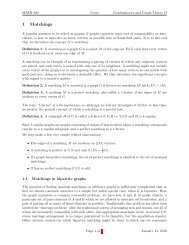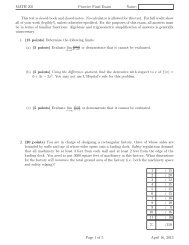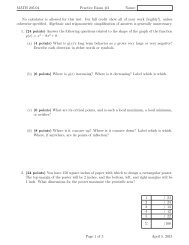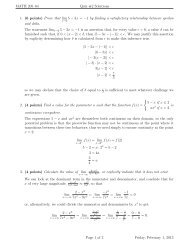MATH 387 Problem Set #7 solutions 7.2.1. (a) Find the coefficient of ...
MATH 387 Problem Set #7 solutions 7.2.1. (a) Find the coefficient of ...
MATH 387 Problem Set #7 solutions 7.2.1. (a) Find the coefficient of ...
- No tags were found...
Create successful ePaper yourself
Turn your PDF publications into a flip-book with our unique Google optimized e-Paper software.
<strong>MATH</strong> <strong>387</strong><strong>Problem</strong> <strong>Set</strong> <strong>#7</strong> <strong>solutions</strong><strong>7.2.1.</strong> (a) <strong>Find</strong> <strong>the</strong> <strong>coefficient</strong> <strong>of</strong> z k in (z 4 + z 5 + z 6 + z 7 + · · · ) 5 , k ≥ 20.1We use <strong>the</strong> known series expansion = ∑ ∞( n+l−1)(1−z) l n=0 l−1 z n below:(z 4 + z 5 + z 6 + z 7 + · · · ) 5 = (z 4 ) 5 (1 + z + z 2 + z 3 + · · · ) 5) 5( 1= z 20 1 − z∑ ∞ ( ) n + 5 − 1= z 20 z n5 − 1n=0∞∑( ) n + 4=z n+204This is an acceptable but not entirely canonical representation <strong>of</strong> <strong>the</strong> generatingfunction: to be standardized (and useful for answering <strong>the</strong> question asked) we’dlike to change <strong>the</strong> exponent on z to be a single variable. So let k = n + 20,replacing every n above with k − 20:∞∑k−20=0n=0( )(k − 20) + 4z k =4∞∑( ) k − 16z k4so <strong>the</strong> <strong>coefficient</strong> <strong>of</strong> z k is ( )k−164 for z ≥ 20 (and for z < 20, <strong>the</strong> <strong>coefficient</strong> is zero,as <strong>the</strong>se terms do not appear in <strong>the</strong> series expansion).(b) <strong>Find</strong> <strong>the</strong> <strong>coefficient</strong> <strong>of</strong> z k in (z + z 3 + z 5 )(1 + z) n , k ≥ 5.We use <strong>the</strong> known binomial expansion (1+z) n = ∑ ∞( ni=0 i)z i below. Note that <strong>the</strong>upper bound can be ∞, since every binomial <strong>coefficient</strong> ( nk)with k > n is zero;this is not necessary, but actually makes our series manipulation easier, since weneed not worry about <strong>the</strong> upper limit <strong>of</strong> <strong>the</strong> sum:∞∑( ) n(z + z 3 + z 5 )(1 + z) n = (z + z 3 + z 5 ) z ii=∞∑i=0i=0( ni)z i+1 +k=20∞∑i=0( ni)z i+3 +∞∑i=0( ni)z i+5Now we need to perform index-shifts on each sum to get our z-terms to match;so we introduce new indices k = i + 1, k = i + 3, and k = i + 5 to <strong>the</strong> three sums:∞∑( ) nz i+1 +ii=0∞∑i=0( ni)z i+3 +∞∑i=0( ni)z i+5∞∑( ) n∞∑( ) n∞∑( ) n=z k +z k +z kk − 1k − 3k − 5k=1k=3k=5[( ] [( ]n n∞∑[( ) ( ) ( )]n n n= z + nz 2 + + 1 z2)3 + + n z3)4 ++ + z kk − 1 k − 3 k − 3k=5Page 1 <strong>of</strong> 6 March 4, 2008
<strong>MATH</strong> <strong>387</strong><strong>Problem</strong> <strong>Set</strong> <strong>#7</strong> <strong>solutions</strong>7.3.3. <strong>Find</strong> a generating function for a n , <strong>the</strong> number <strong>of</strong> partitions <strong>of</strong> n into(a) Odd integers.A partition <strong>of</strong> n into odd numbers can specifically be considered as a partitioninto x 1 ones, x 3 threes, x 5 fives, etc.; <strong>the</strong>n, <strong>the</strong>se variables conform to <strong>the</strong> equationx 1 +3x 3 +5x 5 +· · · = n. The generating function describing <strong>the</strong> number <strong>of</strong> <strong>solutions</strong>to this equation is <strong>the</strong> product <strong>of</strong> <strong>the</strong> generating functions for <strong>the</strong> individualchoices <strong>of</strong> x 1 , x 3 , x 5 , etc. Thus, we have <strong>the</strong> product(1+z+z 2 +z 3 +· · · )(1+z 3 +z 6 +z 9 +· · · )(1+z 5 +z 10 +z 15 ) · · · =1(1 − z)(1 − z 3 )(1 − z 5 ) · · ·(b) Distinct odd integers.This is as above, but with each x i constrained to be zero or 1, so we have finitegenerating functions for each individual choice, yielding:(1 + z)(1 + z 3 )(1 + z 5 )(1 + z 7 ) · · ·7.3.4. <strong>Find</strong> a product whose expansion can be used to find <strong>the</strong> number <strong>of</strong> partitions <strong>of</strong>(a) 12 with even summands.For even summands we are determining <strong>the</strong> number <strong>of</strong> nonnegative <strong>solutions</strong> to<strong>the</strong> equation 2x 2 + 4x 4 + 6x 6 + 8x 8 + 10x 10 + 12x 12 = 12. The generating functionfor each <strong>of</strong> <strong>the</strong>se can, in <strong>the</strong> interest <strong>of</strong> yielding a finite product, be capped at <strong>the</strong>z 12 term, and <strong>the</strong>ir product is thus(1+z 2 +z 4 +z 6 +z 8 +z 10 +z 12 )(1+z 4 +z 8 +z 12 )(1+z 6 +z 12 )(1+z 8 )(1+z 10 )(1+z 12 )whose product is an enormous 66th-degree polynomial, in which <strong>the</strong> only term<strong>of</strong> interest to us is 11z 12 (so <strong>the</strong>re are 11 even-term partitions <strong>of</strong> 12; unsurprisingsince each is <strong>the</strong> double <strong>of</strong> one <strong>of</strong> <strong>the</strong> 11 free partitions <strong>of</strong> 6).(b) 10 with summands greater than 2.We are determining <strong>the</strong> number <strong>of</strong> nonnegative <strong>solutions</strong> to 3x 3 +4x 4 +5x 5 +· · ·+10x 10 = 10; we do this by multiplying <strong>the</strong> generating functions for each summand,capping each series with <strong>the</strong> z 10 term to get polynomials instead <strong>of</strong> series, andthus get(1 + z 3 + z 6 + z 9 )(1 + z 4 + z 8 )(1 + z 5 + z 10 )(1 + z 6 )(1 + z 7 )(1 + z 8 )(1 + z 9 )(1 + z 10 )whose product is a 67th-degree polynomial, in which we are interested in <strong>the</strong> term5z 10 , denoting 5 partitions <strong>of</strong> 10 into parts 3 or larger; we can, knowing <strong>the</strong>re areso few, actually explicitly enumerate <strong>the</strong>m: 3 + 3 + 4, 3 + 7, 4 + 6, 5 + 5, and 10.(c) 9 with distinct summands.We are determining <strong>the</strong> number <strong>of</strong> <strong>solutions</strong> to x 1 + 2x 2 + 3x 3 + · · · + 9x 9 = 9with each x i ∈ {0, 1}. Thus <strong>the</strong> generating functions for individual summandsare binomials, and we multiply <strong>the</strong>m as such:(1 + z)(1 + z 2 )(1 + z 3 )(1 + z 4 )(1 + z 5 )(1 + z 6 )(1 + z 7 )(1 + z 8 )(1 + z 9 )Page 4 <strong>of</strong> 6 March 4, 2008
<strong>MATH</strong> <strong>387</strong><strong>Problem</strong> <strong>Set</strong> <strong>#7</strong> <strong>solutions</strong>to get a 45th-degree polynomial which contains <strong>the</strong> term 8z 9 , indicating 8 partitions<strong>of</strong> 9 into distinct summands. The complete list <strong>of</strong> <strong>the</strong>se is 1+2+6, 1+3+5,2 + 3 + 4, 1 + 8, 2 + 7, 3 + 6, 4 + 5, and 9.7.3.6. (a) Show that <strong>the</strong> number <strong>of</strong> partitions <strong>of</strong> n − 1 is exactly equal to <strong>the</strong> number <strong>of</strong>partitions <strong>of</strong> n whose smallest summand is 1.One could do this with generating functions: we know that(1 + z + z 2 + · · · )(1 + z 2 + z 4 + · · · )(1 + z 3 + z 6 + · · · ) · · · =∞∑p(n)z nbut if we force our partitions to contain at least one “1”, <strong>the</strong> first factor in <strong>the</strong>above product becomes (z + z 2 + z 3 + · · · ) = z(1 + z + z 2 ), yielding <strong>the</strong> generatingfunction∞∑∞∑∞∑z p(n)z n = p(n)z n+1 = p(n − 1)z nn=0n=0So we see that forcing at least one 1 in a partition <strong>of</strong> n elements is possible inp(n − 1) ways.We could also accomplish this with an explicit bijection. Any partition <strong>of</strong> n witha 1 in its expansion can be mapped to a partition <strong>of</strong> n − 1 by simply removing <strong>the</strong>1; this is clearly a bijective map since it can be reversed by taking any partition<strong>of</strong> n − 1 and adding a single 1 to it. Since this is a bijection, <strong>the</strong> two sets involvedmust be <strong>of</strong> equal size.(b) Describe <strong>the</strong> partitions <strong>of</strong> n that are counted by <strong>the</strong> expression p(n) − p(n − 1).We know p(n) counts <strong>the</strong> partitions <strong>of</strong> n; and from <strong>the</strong> above conclusion weknow that p(n − 1) counts <strong>the</strong> partitions <strong>of</strong> n which have a 1 in <strong>the</strong>ir expansion.Thus, <strong>the</strong>ir difference counts <strong>the</strong> partitions <strong>of</strong> n which do not contain a 1 in <strong>the</strong>irexpansions.Let P n be <strong>the</strong> set <strong>of</strong> partitions <strong>of</strong> n, so that |P n | = p(n). Then p(n) − p(n − 1)would be <strong>the</strong> size <strong>of</strong> P n with some set bijectively mapped to P n−1 removed. Thereis a simple injection <strong>of</strong> P n−1 into P n : simply add a single “1” to every partitionin P n−1 to get a partition from P n−1 . The set mapped onto by this operationis precisely those partitions <strong>of</strong> P n containing “1” in <strong>the</strong>ir expansions, since thisprocedure could be reversed by removing a “1”. The set yielded by removing all<strong>the</strong>se images <strong>of</strong> P n−1 from P n is thus those partitions <strong>of</strong> n not using <strong>the</strong> number1; and this is what is counted by p(n) − p(n − 1).7.3.7. Use <strong>the</strong> Ferrer’s graph to show that <strong>the</strong> number <strong>of</strong> partitions <strong>of</strong> n into exactly ksummands equals <strong>the</strong> number <strong>of</strong> partitions <strong>of</strong> n having its largest summand equal to k.All one needs to do is consider <strong>the</strong> transpose. A Ferrer’s graph associated with apartition into k summands will have height exactly k, and thus, its transpose willhave width exactly k, meaning that one <strong>of</strong> its summands is size k but none exceed k.Since <strong>the</strong> transpose is a bijective map, <strong>the</strong> partitions satisfying <strong>the</strong>se two conditionsare equinumerous.n=1n=0Page 5 <strong>of</strong> 6 March 4, 2008
<strong>MATH</strong> <strong>387</strong><strong>Problem</strong> <strong>Set</strong> <strong>#7</strong> <strong>solutions</strong>7.3.14. <strong>Find</strong> a generating function for <strong>the</strong> number <strong>of</strong> partitions <strong>of</strong> n into(a) Summands no larger than 4.We want nonnegative <strong>solutions</strong> to x 1 +2x 2 +3x 6 +4x 4 = n, which can be expressedas a product <strong>of</strong> <strong>the</strong> four individual generating functions for decision <strong>of</strong> x 1 , x 2 , x 3 ,and x 4 :(1+z+z 2 +z 3 +· · · )(1+z 2 +z 4 +z 6 +· · · )(1+z 3 +z 6 +z 9 +· · · )(1+z 4 +z 8 +z 12 +· · · )(b) Summands <strong>the</strong> largest <strong>of</strong> which is 4.This is as above, except we require at least one 4, so we constrain x 4 ≥ 1, whichaffects <strong>the</strong> fourth multiplicand in our expression:(1+z +z 2 +z 3 +· · · )(1+z 2 +z 4 +z 6 +· · · )(1+z 3 +z 6 +z 9 +· · · )(z 4 +z 8 +z 12 +· · · )(c) At most four summands.By <strong>the</strong> transposition bijection on Ferrer’s diagrams we know this is an identicalenumeration to part (a), and thus has <strong>the</strong> same generating function.(d) Exactly four summands.By <strong>the</strong> transposition bijection on Ferrer’s diagrams we know this is an identicalenumeration to part (a), and thus has <strong>the</strong> same generating function.Page 6 <strong>of</strong> 6 March 4, 2008


